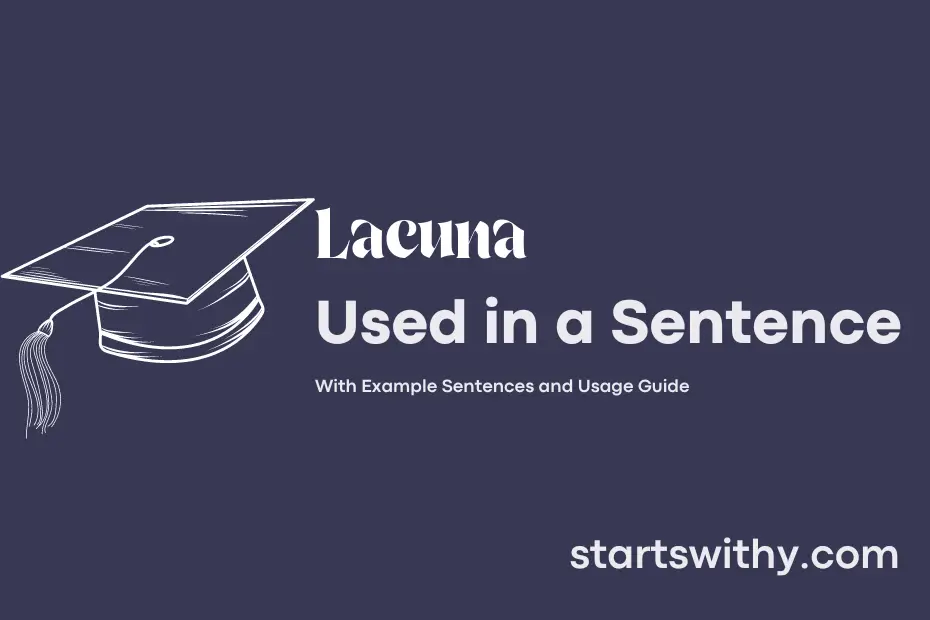Have you ever heard of a “lacuna” in writing or speech? A lacuna is a gap or missing part in a text or conversation, leaving something unsaid or unexplained.
In language, a lacuna can create confusion or ambiguity, highlighting the importance of clear communication. Keep reading to discover how to identify and avoid lacunae in your own writing and speech.
7 Examples Of Lacuna Used In a Sentence For Kids
- Lacuna means a missing part.
- We can fill the lacuna with our imagination.
- Let’s find the lacuna and complete the picture.
- There is a big lacuna in this puzzle.
- Can you spot the lacuna in the story we read?
- We need to fill the lacuna in the sentence to make it complete.
- The artist left a lacuna in the painting for us to fill.
14 Sentences with Lacuna Examples
- Lacuna in my understanding of the subject led to a poor performance in the exam.
- The professor’s explanation filled the lacuna in my notes, helping me better understand the concept.
- Ignoring the lacuna in your research could weaken the credibility of your thesis.
- I need to address the lacuna in my presentation before delivering it to the class.
- The lacuna in the library’s collection made it challenging to find relevant resources for my project.
- Finding a tutor to help fill the lacuna in my understanding of calculus was crucial for my academic success.
- It’s important to identify and resolve any lacunae in your knowledge before the final exams.
- The group project suffered due to a lacuna in communication among team members.
- The workshop on time management addressed the lacunae in many students’ organizational skills.
- A lacuna in the syllabus meant that students had to seek additional resources to fully grasp the topic.
- The dean emphasized the need to bridge the lacuna between industry requirements and the curriculum.
- Not acknowledging the lacuna in your research methodology can lead to flawed results.
- Collaborating with classmates can help fill the lacuna in your notes from missed lectures.
- The student committee worked to eliminate the lacunae in campus facilities for differently-abled students.
How To Use Lacuna in Sentences?
Lacuna is a word that refers to a gap or missing part in a text or a story. When using Lacuna in a sentence, it is important to understand its meaning and how to properly incorporate it into your writing.
To use Lacuna in a sentence, you can follow these simple steps:
-
Identify the point in the text or story where there is a gap or missing information. This is where you can use Lacuna.
-
Introduce Lacuna into your sentence by placing it in the appropriate location. For example, “There was a Lacuna in the detective’s investigation that needed to be filled in order to solve the case.”
-
Make sure that the sentence flows smoothly and that the use of Lacuna makes sense in the context. You can also provide further detail or explanation to clarify the Lacuna if needed.
-
Read over your sentence to ensure that it effectively conveys the idea of a gap or missing part in the text or story.
By following these steps, you can effectively use Lacuna in a sentence with confidence and clarity. Practicing incorporating Lacuna into your writing will help you become more comfortable and skilled at using this word in various contexts.
Conclusion
In writing, a lacuna refers to a gap or missing part in a text, such as missing words, phrases, or sections. These gaps can create confusion for readers and affect the overall clarity and coherence of the writing. To avoid such lacunae, it is essential for writers to carefully review their work and ensure that all necessary information is present and clearly conveyed.
By identifying and filling in any lacunae in their writing, writers can enhance the readability and impact of their work. It is important to address these gaps to provide readers with a complete and comprehensive understanding of the text. Ultimately, addressing lacunae in writing helps to maintain consistency, coherence, and effectiveness in communications.



